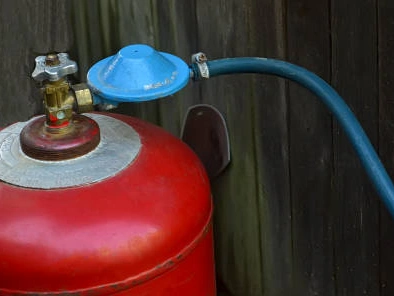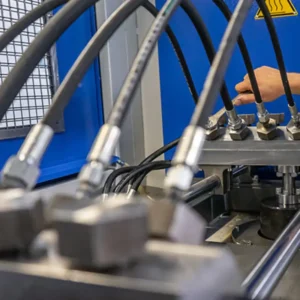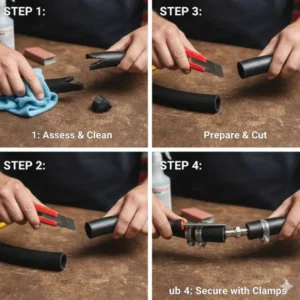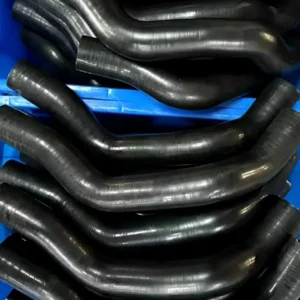When we think about the key components of any propane system, propane hoses are a critical piece of the puzzle. For us, understanding the materials of propane hoses is not only about technical specifications, but also about ensuring safety, reliability, and customer satisfaction. A deeper understanding of propane hose materials, construction, and types will help you better serve your customers and maintain the highest industry standards.
What is Propane Hose Made Of

Propane hoses are engineered products, designed to transport a highly flammable gas under pressure safely. This rigorous requirement means they are far from simple tubes; they are multi-layered constructions, with each component meticulously chosen to ensure durability, prevent leaks, and meet stringent safety regulations. Let’s break down the primary materials and their critical roles in manufacturing a robust and reliable propane hose.
Inner Tube: The Core for Gas Containment
The inner tube is the initial point of contact with propane, making its material selection paramount. It must exhibit exceptional resistance to the chemical properties of propane and maintain its integrity and flexibility across a broad range of temperatures. We prioritize materials that will not degrade, crack, or become brittle when exposed to the gas, ensuring a long-lasting and secure seal.
- Nitrile Rubber (NBR): For most high-quality propane hoses we supply, NBR is the preferred material for the inner tube. Its superior resistance to hydrocarbons like propane, along with oils and various chemicals, makes it an ideal choice. NBR also maintains excellent flexibility, even in cold conditions, which is crucial for outdoor and industrial applications. It consistently performs well for both liquid and vapor propane transfer.
- Specialized Synthetic Rubbers: While NBR covers the vast majority of our offerings, some highly specialized applications may necessitate other synthetic rubbers. These are typically chosen for enhanced properties such as extremely high-temperature tolerance or very specific chemical compatibility, but for general-purpose propane hoses, NBR remains the industry benchmark we rely on.
Reinforcement Layer: Providing Structural Integrity
An inner tube alone isn’t sufficient for containing pressurized propane and resisting external stresses. The reinforcement layer provides the critical structural integrity, preventing expansion, kinking, and bursting under pressure. This layer is what allows the hose to maintain its shape and flow efficiency under demanding conditions.
- Braided Textile (Polyester or Nylon): We commonly utilize high-strength polyester or nylon fibers woven into a braided pattern for the reinforcement layer. This braiding technique provides exceptional tensile strength, effectively containing internal pressure and preventing the hose from ballooning or rupturing. It’s a balance of strength and flexibility that’s essential for various applications.
- Spiral Steel Wire: For our higher-pressure or more demanding industrial hoses, we incorporate spiral steel wire reinforcement. This significantly enhances rigidity and crush resistance, making the hose incredibly durable. While it may reduce flexibility slightly compared to textile-braided hoses, its performance in high-stress environments is unparalleled.
Outer Cover: Shielding from Environmental Hazards
The outer cover acts as the hose’s protective shield, defending the inner layers from external damage and environmental degradation. Given that many propane hoses are used outdoors, this layer must be robust enough to withstand a variety of challenges, ensuring the hose’s longevity and continued performance.
- EPDM Rubber (Ethylene Propylene Diene Monomer): We consistently choose EPDM for the outer cover due to its outstanding resistance to weathering, UV radiation, ozone, and abrasion. Its ability to remain flexible across a wide temperature range makes it ideal for diverse climates. The familiar black color of most quality propane hoses often signifies an EPDM outer cover.
- Thermoplastic Materials: For certain hose designs, particularly those focused on lighter weight or specific flex properties, we may utilize advanced thermoplastic elastomers (TPEs). These materials offer a desirable combination of flexibility, durability, and environmental resistance, while also potentially reducing the overall weight of the hose assembly.
Is There a Difference Between Natural Gas Hose and Propane Hose?

The main difference between natural gas hoses and propane hoses is the pressure they are designed to withstand. Propane is stored and delivered at much higher pressures (about 100-200 PSI in the tank, which drops to about 11 inches of water or 0.4 PSI at the appliance) than natural gas (usually about 3.5-7 inches of water or 0.25 PSI).
Propane hoses have thicker walls and more robust reinforcement to safely withstand this higher pressure. Natural gas hoses are generally not as heavily reinforced due to the lower pressure requirements.
Natural gas hoses and propane hoses often have different fittings and connectors that are specifically designed to prevent improper connections. Attempting to use a natural gas hose to deliver propane could result in dangerous leaks or hose ruptures, while using a propane hose to deliver natural gas could result in insufficient gas flow that would affect the proper operation of the appliance. Always use a hose designed for the type of gas you are connecting.
Common Types of Propane Hoses and Their Construction
Propane hoses are designed with specific applications in mind, leading to variations in their construction. Understanding these distinct types is crucial for us to recommend the correct product to our customers, ensuring optimal performance and safety for their particular needs. Let’s outline the most common types we encounter and how their construction aligns with their intended use.
| Hose Type | Typical Construction Features | Common Applications |
| Standard Grill Hose | NBR inner tube, braided textile reinforcement (polyester), EPDM outer cover. Usually 3-6 feet in length, designed for common household use. | BBQ grills, patio heaters, residential fire pits. |
| Appliance Connector | Similar core construction to grill hoses, but often shorter (1-3 feet) with specific fittings for smaller appliances like camp stoves or lanterns. | Portable camping stoves, lanterns, small outdoor heaters, portable gas appliances. |
| High-Pressure Hose | NBR inner tube, multiple layers of braided textile or spiral steel wire reinforcement, thick EPDM or heavily reinforced thermoplastic cover. | Industrial burners, large commercial cooking equipment, high-BTU outdoor heating, specific industrial applications. |
| Extension Hose | Standard hose construction, specifically designed to extend the reach of an existing propane connection. Features compatible male and female fittings. | Connecting appliances further from the propane tank, often used for RVs, larger outdoor kitchens, or commercial setups. |
| RV/Motorhome Hose | Durable construction with enhanced UV protection and vibration resistance. Engineered to withstand the dynamic environment of mobile recreational vehicles. | Connecting onboard propane tanks to appliances within recreational vehicles. |
| Pigtail Hose | Short, rigid hose (often stainless steel braided or heavily reinforced rubber) specifically designed to connect a propane tank to a regulator. | Connecting OPD (Overfill Prevention Device) tanks to regulators on RVs, trailers, or fixed installations. |
Regulator Hoses: An Integrated Solution
Many residential and light commercial propane appliances incorporate a regulator hose as a single, integrated unit. This assembly includes a pressure regulator—which reduces the high tank pressure to a safe, usable level for the appliance—and a segment of hose.
The hose portion of these units adheres to the same fundamental construction principles as a standard grill hose: an NBR inner tube, textile reinforcement, and an EPDM outer cover. The key advantage is its factory-sealed attachment to the regulator, ensuring a tested and reliable connection right out of the box.
The Importance of Propane Hose Materials

The material composition of a propane hose is not merely a design choice; it is a fundamental element in guaranteeing both safety and performance.
As suppliers, we recognize that using incorrect or inferior materials can lead to severe hazards, including gas leaks, fires, or explosions. We depend on these carefully selected materials to consistently withstand the unique challenges inherent in propane transport.
Resistance to Propane Degradation
Propane, being a hydrocarbon, can chemically degrade certain types of rubber or plastic over time. Materials like NBR are specifically chosen for their excellent resistance to hydrocarbon absorption and long-term degradation.
If an inner tube were made of an incompatible material, it would swell, crack, or become permeable, leading to dangerous gas leaks. This material compatibility is absolutely paramount for the long-term integrity and safety of the hose we supply.
Pressure Integrity and Rating
Propane is stored and delivered under pressure. The reinforcement layer is crucial for maintaining this pressure safely within the hose. All quality hoses are manufactured with a defined working pressure (the maximum safe operating pressure) and a burst pressure (the pressure at which the hose is expected to fail).
We ensure that the hoses we offer are rated well above typical operating pressures, providing a significant safety margin for our customers. We always emphasize selecting a hose whose pressure rating exceeds the demands of the intended appliance.
Temperature Resilience
Propane hoses must perform reliably across diverse climatic conditions, from freezing winters to scorching summers. The materials, particularly the inner tube and outer cover, must retain their flexibility and structural integrity over wide temperature ranges.
A hose that becomes brittle in the cold is prone to cracking and leaks, while one that softens excessively in heat could compromise its pressure rating. EPDM and NBR are selected for their ability to maintain their physical properties typically from -40°F to 140°F (-40°C to 60°C), ensuring consistent performance for our customers.
UV and Abrasion Protection
Outdoor applications expose propane hoses to damaging ultraviolet (UV) radiation and potential physical abrasion. The outer cover is specifically designed to shield the internal layers from these environmental aggressors. Materials like EPDM provide superior resistance to UV degradation and possess the toughness required to withstand reasonable wear and tear, significantly extending the hose’s service life. This durability is a key selling point for our products.
Maintenance Tips for Longevity and Safety
Even the most robust propane hose requires proper care to ensure its longevity and safe operation. As suppliers, we play a vital role in educating our customers on regular inspection and good maintenance practices. These simple guidelines can significantly extend the life of the hoses we sell and, more importantly, prevent hazardous incidents.
Visual Inspection: Educating on What to Look For
We advise our customers to perform a quick visual inspection of their propane hose before each use. This empowers them to identify potential issues early. We recommend looking for:
- Cracks or Fissures: Especially near fittings or along the length of the hose. These often indicate material degradation due to age, UV exposure, or chemical attack.
- Bulges or Swelling: A clear sign of weakening in the reinforcement layer, which is a critical safety hazard, indicating potential rupture.
- Fraying or Cuts: Any damage to the outer cover exposes internal layers to further degradation.
- Abrasions: Excessive wear marks suggest the hose is rubbing against something abrasive, requiring repositioning or protection.
- Discoloration: Significant fading or changes in color, particularly on the outer cover, can signal prolonged UV exposure and potential material brittleness.
Leak Detection: The Soapy Water Test Demonstration
We strongly advocate for the simple yet highly effective soapy water test to detect invisible leaks. This is a critical safety practice we encourage all our customers to perform regularly.
- Full Connection: Emphasize ensuring the propane tank is fully connected to the hose, and the hose is securely connected to the appliance.
- Gas On: Instruct them to slowly open the propane tank valve to allow gas flow into the hose (without igniting the appliance).
- Apply Solution: Advise mixing dish soap and water in a spray bottle and generously spraying all connections and the entire length of the hose.
- Observe for Bubbles: Crucially, if bubbles form anywhere, it indicates a leak. Even small, consistent bubbles signal a problem.
- Immediate Action: Stress the importance of immediately closing the propane tank valve if a leak is detected. The hose or appliance should not be used until the leak is professionally addressed or the hose is replaced.
Proper Storage and Handling Best Practices
How a hose is stored and handled directly impacts its lifespan. We guide our customers on best practices to prevent premature failure:
- Avoid Kinking: Advise coiling the hose loosely for storage, avoiding sharp bends or kinks that can damage internal reinforcement.
- Protect from Elements and Pests: Recommend storing hoses indoors or in a shaded area away from direct sunlight to prevent UV degradation. Also, mention keeping them away from rodents that might chew on them.
- Maintain Cleanliness: Encourage keeping hoses free from grease, oil, or harsh chemicals, as these can degrade rubber compounds.
- Minimize Temperature Extremes: While hoses are designed for temperature variations, avoiding prolonged storage in extreme heat or cold can contribute to their longevity.
Conclusion
As a supplier, we have a deep understanding of the materials used to make propane hoses, which reflects our commitment to providing safe, reliable, high-performance products.
From the chemical resistance of the NBR inner tube to the protection of the EPDM outer layer to the strength of the braided reinforcement layer, our careful engineering design ensures that each hose meets strict safety standards and performs efficiently. We are committed to being your trusted partner in providing the highest quality propane hose solutions.




